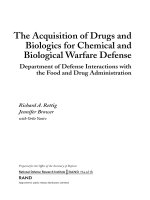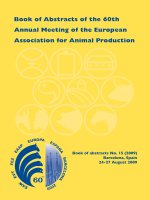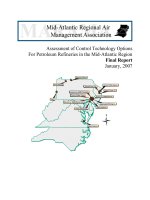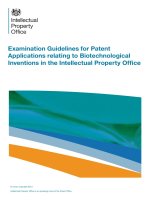laser sintering of thick film conductors for microelectronic applications
Bạn đang xem bản rút gọn của tài liệu. Xem và tải ngay bản đầy đủ của tài liệu tại đây (1.02 MB, 9 trang )
Laser sintering of thick-film conductors for microelectronic applications
Edward C. Kinzel
School of Mechanical Engineering, Purdue University, West Lafayette, Indiana 47907
Hjalti H. Sigmarsson
School of Electrical and Computer Engineering, Purdue University, West Lafayette, Indiana 47907
Xianfan Xu
a͒
School of Mechanical Engineering, Purdue University, West Lafayette, Indiana 47907
William J. Chappell
School of Electrical and Computer Engineering, Purdue University, West Lafayette, Indiana 47907
͑Received 14 August 2006; accepted 28 November 2006; published online 20 March 2007͒
This paper investigates fabrication of functional thick metal films using simultaneous laser sintering
and patterning along with the fundamental physical phenomena that govern the laser sintering
process. The effects of the processing parameters on the quality of the fabricated components are
investigated through a heat transfer analysis. We show that our process has potentials for
metallization of microelectronics directly onto substrates whose melting temperatures are much
lower than the temperature needed for sintering, which is only possible by properly controlling the
temperature field during laser sintering. Optimum properties of the fabricated components are
obtained when certain thermal conditions are produced during laser heating. © 2007 American
Institute of Physics. ͓DOI: 10.1063/1.2433711͔
I. INTRODUCTION
The conventional process for fabricating thick-film mi-
croelectronics is a mature technology. It consists of screen
printing a pattern onto a substrate using a process similar to
the one used since antiquity for the creation of artwork and
decoration. The pattern and substrate are then dried and fired
in a high temperature furnace to functionalize the ink. The
process is capable of patterning different materials ͑e.g., con-
ductive, resistive, and dielectric elements͒ and screen-
printable inks have been specifically developed and are com-
mercially available. In addition, the low temperature cofired
ceramic ͑LTCC͒ approach to packaging allows the fabrica-
tion of integrated multilayer circuits with buried passive
components. Screen printing can produce feature sizes down
to 75
m; however, the substrate must be capable of with-
standing the firing temperature of the ink, which is typically
around 850 °C for commonly used ceramic-metal inks.
1
This
limits the choice of substrates to materials such as alumina
and prevents the use of low temperature and low cost sub-
strates which are ideal for applications such as disposable
microelectronic devices such as radio frequency identifica-
tion ͑RFID͒-type tags and sensors. Polymer based thick-film
inks have processing temperatures as low as 120 ° C; how-
ever, this lower firing temperature comes at the expense of
electrical performance.
1
Inks based on metallic nanoparticles
have also been demonstrated to have good conductivity at
low processing temperatures,
2
although the affordability of
these inks is not apparent.
It is desirable to extend the range of possible substrates
to include glass and polymers while maintaining the conven-
tional thick-film performance and economy. In addition, in-
creases in operational frequency and interconnect density are
generating a demand for quality devices with feature sizes
less than 75
m.
3
Recently, several approaches have been
developed to direct write microelectronic devices with me-
soscopic feature sizes ͑10
m–10 mm͒ such as ink-jet print-
ing and matrix-assisted pulsed laser evaporation-direct write
͑MAPLE-DW͒.
3
Most of these processes provide rapid-
prototyping capabilities; however, the patterns deposited by
these technologies still require functionalization at high tem-
peratures after deposition. An alternative is using a laser to
locally sinter the ink while minimizing the heating of the
substrate. Marinov
4
investigated the dc resistance of compo-
nents fabricated using a combination of deposition of chemi-
cal precursors followed by laser sintering. Laser sintering has
also been proposed for use with direct write techniques such
as MAPLE-DW ͑Ref. 3͒ and has been demonstrated with
ink-jet printing by Bieri et al.
2
Our recent work
5,6
has demonstrated the viability of us-
ing the laser sintering technique to simultaneously pattern
and functionalize microcircuits using conventional thick-film
inks on substrates with damage thresholds below the firing
temperature of the ink. This paper describes a detailed inves-
tigation of the process of the laser sintering, particularly the
heat transfer process driving the laser sintering and the tem-
perature profile needed for successful sintering of high tem-
perature inks on substrates with low thermal damage thresh-
olds. The finite element method is implemented to
numerically simulate the transient temperature profile within
the ink layer and the substrate. The effects of the process
parameters on the electrical performance of the conductors
are identified and correlated with the thermal profiles during
laser sintering.
a͒
Author to whom correspondence should be addressed; electronic mail:
JOURNAL OF APPLIED PHYSICS 101, 063106 ͑2007͒
0021-8979/2007/101͑6͒/063106/9/$23.00 © 2007 American Institute of Physics101, 063106-1
Downloaded 13 Dec 2007 to 128.46.193.173. Redistribution subject to AIP license or copyright; see />II. EXPERIMENT
Figure 1 shows a schematic of the experimental setup.
The entire process takes place in an ambient nonclean room
environment. The setup incorporates two continuous wave
͑cw͒ lasers which provide the ability to process materials
with different optical absorptivities. A 9 W cw fiber laser
͑JDS Uniphase IFL9͒ with a wavelength of 1.10
m was
used for all the experiments presented in this work. The
beam is focused to a spot size of ϳ20
m on the substrate
using a lens with a focal length of 165 mm. The optical
x-y scanner consists of two mirrors each of which is attached
to a servomotor. The servomotors as well as the laser on and
off are computer controlled so that the laser beam traces a
pattern on the substrate. This approach allows the focal point
to be moved at speeds greater than 1 m/s without sacrificing
precision ͑Ͻ2
m lateral positioning accuracy͒. The high
speed makes this approach attractive for both rapid-
prototyping and higher-volume production. The process is
monitored in situ with a charge coupled device ͑CCD͒ cam-
era which allows alignment of the sample and sintering of
multiple layers.
A. Fabrication
DuPont QS300, a commercial silver based thick-film
ink, is used in this work. This ink was developed for the
conventional screen printing process and has a specified fir-
ing temperature of 850 ° C. The ink is intended for high tem-
perature substrates such as alumina and normally cannot be
processed on glass or polymer substrates because these sub-
strates cannot survive the bulk firing temperatures. Like most
conventional thick-film inks, QS300 is a combination of
functional particles ͑submicron silver, platinum, and other
conductors͒, along with glass frit ͑which serves as a binder͒
and organic rheological agents adjusted for the screen print-
ing process. The ink has a quoted sheet resistance of
4.5 m⍀/ᮀ fora10
m fired thickness which corresponds to
a conductivity
of 2.22ϫ 10
7
S/m or 36% of the conduc-
tivity of bulk silver ͑6.17ϫ10
7
S/m͒.
The work presented in this paper uses soda-lime glass
substrates ͑standard laboratory microscope slides͒. Soda-
lime glass has a damage threshold of ϳ550 °C which is
about 300 ° C lower than the specified firing temperature of
QS300. In the experiments, the ink is diluted with thinner
͑
␣
-terpineol͒ to lower its viscosity which permits the ink to
be applied to the glass substrate. The final wet ink film is
5–10
m thick after coating. The ink is then dried in a con-
vection oven at a temperature of 150 ° C to remove the thin-
ner and any other volatile organic materials. After drying, the
ink is sintered by scanning the laser in the pattern to be
generated, as shown in Fig. 2. Once the entire pattern has
been sintered, the ink that is not sintered is removed using a
solvent such as methanol. Other materials can also be pat-
terned on top of previously sintered layers to form structures
such as capacitors
7
and resistor networks. Once the final
layer is sintered and the unsintered material removed, the
pattern is fully functional with no need of additional postpro-
cessing. An example of this functionality is the dc resistance
which is measured to characterize its electrical performance.
B. Morphology of laser sintered ink
A parametric study was performed to investigate the ef-
fects of the laser processing parameters on the morphology
of laser sintered patterns. Lines were created on a 200
m
pitch by moving the laser once over the dried ink. A Tencor
Alpha-Step IQ stylus profilometer was used to measure the
surface topography. The profiles for several of the sintered
lines generated with different laser parameters are shown in
Fig. 3. The figure shows that when higher laser powers are
used, two bumps form on either side of the centerline traced
by the laser. This indicates that where the irradiance of the
laser ͑and thus temperature of the ink͒ is the highest, the ink
is melted and flows laterally due to Marangoni effects.
8
As
the intensity of the laser is decreased the amount of melt flow
decreases until a continuous line is produced, as shown in
Fig. 3͑d͒.
Using the laser focusing condition described previously,
further experimentation was able to produce continuous lines
with widths less than 25
m. The height of these lines is
close to 1
m. Figure 4 shows a top view and topographic
scans of these lines with a 100
m pitch. These conductive
lines were created by moving the laser across the ink layer at
a speed of 0.90 m/ s and a power of 1.01 W ͑measured at the
ink surface͒.
C. dc resistance measurements
The electrical performance of the laser sintered patterns
was also investigated using another parametric sweep. Test
patterns consisting of a 10ϫ0.425 mm
2
wire between two
connectors were written with different laser powers and scan
speeds. The larger line width makes the conductors less sen-
sitive to any disparities caused by coating or inconsistencies
in the ink. DuPont QS300 ink was again used with soda-lime
FIG. 1. Schematic of experimental laser sintering setup.
FIG. 2. Laser sintering process.
063106-2 Kinzel et al. J. Appl. Phys. 101, 063106 ͑2007͒
Downloaded 13 Dec 2007 to 128.46.193.173. Redistribution subject to AIP license or copyright; see />glass substrates. The wires were generated by rastering the
laser back and forth with a spacing between the centers of
adjacent lines ͑pitch͒ of 16
m. The laser power and scan
speed were swept over a range from 0.56 to 3.92 W ͑mea-
sured at the ink surface͒ and from 0.1 to 1.0 m /s, respec-
tively. Figure 5 shows micrographs of a number of laser-
sintered wires. These test patterns all have two layers of
sintering. Sintering a second layer helps to fill in voids in the
ink, particularly for high power and low speed to overcome
coalescence and melting of the pattern. After both the first
and second layers were applied the Scotch tape test was con-
ducted and any inadequately bonded material removed.
For low laser powers and high scan speeds the laser
energy is insufficient to sinter the ink or bond the ink to the
substrate and the parts or whole areas of the pattern are re-
moved during the cleaning step, as shown in Figs. 5͑d͒, 5͑g͒,
and 5͑h͒. Within a range of laser powers and scan speeds, the
ink is patterned and functionalized, that is, a relatively uni-
form cross-sectional profile, as shown in Figs. 5͑b͒, 5͑e͒, and
5͑i͒, is produced and the patterns are bonded to the substrate.
Finally, for high laser powers and low scan speeds, portions
of the ink are totally melted and coalesce to form voids in the
pattern. Further, damage to the substrate also occurs as
shown in Figs. 5͑c͒ and 5͑f͒. Surface topographies of several
of these test patterns are also shown in Fig. 6. Melt reflow
and damage to the substrate can be clearly seen at high laser
power and slow scan speed. In some of this the increase in
volume may be due to permanent structural change in the
glass volume very near the interface. This phenomenon is
FIG. 4. Photograph ͑a͒ and profile ͑b͒ of 25
m wide lines on a 100
m
pitch.
FIG. 3. Single pass lines written at ͑a͒ 3.92 W and 0.1 m/s, ͑b͒ 1.40 W and 0.1 m/s, ͑c͒ 3.92 W and 0.4 m / s, and ͑d͒ 1.40 W and 0.4 m/s
063106-3 Kinzel et al. J. Appl. Phys. 101, 063106 ͑2007͒
Downloaded 13 Dec 2007 to 128.46.193.173. Redistribution subject to AIP license or copyright; see />discussed by Shiu et al.
9
and occurs when glass is heated
above its transition temperature and then cooled very rapidly.
The dc resistance across the sintered pattern was mea-
sured using an Agilent 34401A digital multimeter and plotted
in Fig. 7. The figure shows that there is a range of laser
powers and scan speeds which produce much higher resis-
tance at either too high power/low speed or too low power/
high speed. The lowest resistance recorded was 0.355 ⍀ and
occurred for a laser power of 1.96 W and scan speed of
0.1 m/ s. The dc conductivity is
=L/ RA for a wire with
constant cross section, where R is the measured resistance, A
is the cross-sectional area, and L is the length of the pattern.
The minimum resistance corresponds to a conductivity of
1.97ϫ10
7
S/m, which is obtained with a laser power of
2.24 W and a scan speed of 0.1 m/ s, and is 89% of the
specified value produced by bulk sintering. However, it
should be emphasized again that this ink cannot be conven-
tionally bulk sintered on the soda-lime substrate. Additional
improvements to the electrical performance are possible by
further refining the laser processing parameters. This in-
cludes increasing the laser power for the second and any
subsequent layers to take account in the change in the ther-
mal properties of the underlying area. This consideration is
particularly true for small features, in which case it is neces-
sary to use less laser energy to generate the pattern, remove
the material, and then trace the same pattern a second time
with more laser energy to fully functionalize the material.
Also the thickness of the ink can also be optimized to pro-
duce a more advantageous thermal profile within the ink.
III. THERMAL ANALYSIS
Thick-film inks are designed to be processed at certain
temperatures. Therefore, understanding the transient thermal
profile during the processing stage is important. The tem-
perature profile for firing thick-film inks, of which QS300 is
typical, requires heating the ink to 850 °C at a ramp speed of
FIG. 5. Micrographs of test patterns
written at various speeds and laser
powers.
FIG. 6. Cross-sectional profiles of the test patterns in Figs. 5͑d͒, 5͑e͒, and
5͑c͒. FIG. 7. dc resistance in ⍀ for 10 mm wire after two layers of metallization.
063106-4 Kinzel et al. J. Appl. Phys. 101, 063106 ͑2007͒
Downloaded 13 Dec 2007 to 128.46.193.173. Redistribution subject to AIP license or copyright; see />ϳ50 ° C/min, a 10 min dwell at this temperature before
cooling back to room temperature at ϳ50 °C / min.
1
Overall,
the typical firing procedure takes about 1 h. In comparison,
both the heating and cooling generated by laser sintering are
much more rapid with the high temperature at a given point
lasting on the order of milliseconds. Also, there is a sharp
temperature gradient in the ink during laser sintering, with
the temperature at the surface of the ink higher than that at
the ink-substrate interface. Such temperature gradients are
not present in conventional sintering. Melting of the ink,
particularly at the surface, can also occur at higher laser
power and/or lower laser scanning speed, as seen in Figs. 3
and 6. Given the nature of thick-film ink sintering, the opti-
mal condition for the laser process is to bring the tempera-
ture throughout the ink layer to the sintering temperature
͑850 ° C͒ while maintaining the substrate temperature as low
as possible, with the bulk of the substrate below its damage
threshold ͑ϳ550 ° C for soda-lime glasses͒.
It is difficult to measure the temperature inside the ink
and the substrate in situ. However, given the material prop-
erties and laser parameters, the thermal profile can be com-
puted using numerical simulations. In this work, we use the
finite element code
ABAQUS ͑ABAQUS Inc., Providence, RI͒
to calculate the thermal profile generated in the ink and the
substrate for different laser processing parameters and at-
tempt to use the calculation results to explain the experimen-
tal data.
The material properties used in the calculations are cho-
sen to represent the ink as close as possible since the exact
composition of the ink is proprietary. The ink after drying in
the oven and before laser sintering is modeled as a homo-
genous mixture of 90% silver and 10% soda-lime glass by
mass to include the effects of the glass frit. The volatile
organic solvents are assumed to be completely driven off
during the drying prior to exposure to the laser. The density
and specific heat are taken to be the mass-weighted averages
of the temperature dependent constituent properties. The ef-
fective thermal conductivity is calculated using the Maxwell
effective medium theory.
10
This approach is valid for a ran-
dom suspension of spherical particles in a homogenous me-
dium and gives
k
e
k
0
=1+
3
͓͑k
1
+2k
0
͒/͑k
1
− k
0
͔͒ −
, ͑1͒
where
is the volume fraction of the spherical inclusions
and k
0
and k
1
are the thermal conductivities of the medium
and spherical inclusions, in this case the glass frit and the
silver particles. It is noted that Maxwell’s theory is valid only
for low inclusion concentrations and is used here for ap-
proximation due to the lack of accurate effective thermal
conductivity model at high concentrations. Pure silver has a
melting point at 962 ° C and a latent heat of fusion of
103 kJ/kg. Glass does not have a classic latent heat and as
the glass frit is heated it will experience a glass transition
rather than a definitive melting process. Since there is much
more silver by mass, the effects of the glass transition are
assumed to be negligible. The latent heat of ink is then
weighted by the mass fraction of the silver. The effect of
melting is considered in the simulation by replacing the spe-
cific heat c
p
with an effective specific heat c
˜
p
that includes
latent heat effects,
c
˜
p
͑T͒ =
Ά
c
p
͑T͒ T ഛ T
s
, T ജ T
l
c
p
͑T͒ +
h
fg
T
l
− T
s
T
s
ഛ T ഛ T
l
·
. ͑2͒
The latent heat h
fg
is linearly distributed as an addition to the
effective specific heat over a temperature range between T
s
and T
l
, which can be considered as the solidus temperature
for impure materials begin to melt, and the liquidus tempera-
ture when melting is completed. The solidus and liquidus
temperatures used in this work for the ink are 962 and
1012 °C, respectively. Using an effective specific heat per-
mits the entire ink layer to be treated as a continuous me-
dium modeled by a single domain without calculating the
phase boundaries explicitly. The properties of silver are
taken from Incropera and Dewit.
11
The properties of soda-
lime glass substrate are from Kiyohashi et al.
12
and
Touloukian.
13
Since the material properties are not precisely
known, the numerical results are only intended to capture the
trends of the effects of the laser parameters on the thermal
profile and are not expected to produce results that defini-
tively correspond to the experiments. The material properties
for silver, soda-lime glass, and the simulated ink are plotted
in Fig. 8.
The interaction of the laser beam with the ink is modeled
as a volumetric heat source moving at a constant velocity.
For a laser with Gaussian beam profile, the laser flux at a
point ͑x , y͒ on the surface of the ink can be expressed as
I͑x,y,t͒ =
2P
r
0
2
exp
ͫ
−2
͑x − x
0
−
v
x
t͒
2
+ ͑y − y
0
͒
2
r
0
2
ͬ
, ͑3͒
where P is the laser power at the interface, r
0
is the beam
radius ͑1/e
2
͒,
v
x
is the scan velocity in the x direction, and t
is the time.
A portion of the incident laser flux is reflected at the
surface while the remainder is absorbed by the ink layer.
According to Lambert’s law the absorbance produces an ex-
ponential attenuation in the incident field. The laser heat flux
is then given by
q͑x,y,z,t͒ = ͑1−R
f
͒I͑x,y,t͒exp͑−
␣
z͒, ͑4a͒
where
␣
is the attenuation coefficient and R
f
accounts for the
surface reflection. The volumetric distribution of the heat
source term generated by the absorbed laser energy is given
by
Q
ab
=−
dq
dz
=
␣
͑1−R
f
͒I͑x,y,t͒exp͑−
␣
z͒. ͑4b͒
Both
␣
and R
f
are taken as the properties of silver.
The three-dimensional ͑3D͒ transient heat conduction
equation that governs the heat transfer within the material is
c
p
ץ
T
ץ
t
= ٌ͑k ٌ T͒ + Q
ab
, ͑5͒
where c
p
is the specific heat,
is the density, and k is the
thermal conductivity of the medium ͑either the ink or the
substrate͒. There will be heat transfer via conduction across
063106-5 Kinzel et al. J. Appl. Phys. 101, 063106 ͑2007͒
Downloaded 13 Dec 2007 to 128.46.193.173. Redistribution subject to AIP license or copyright; see />the interface between the substrate and the ink layer. The ink
is assumed to completely wet the substrate and the contact
resistance is neglected. Because the heat flux leaving the ink
must be equal to the heat flux entering the substrate, the
thermal profile at the interface is governed by
q
Љ
=
ͯ
− k
i
ץ
T
ץ
z
ͯ
−
=
ͯ
− k
s
ץ
T
ץ
z
ͯ
+
, ͑6͒
where k
i
and k
s
are the thermal conductivities of the ink and
substrate, respectively. The plus and minus signs indicate the
side of the discontinuity at the interface.
During the sintering process the ink layer is cooled by
convection and radiation exchange with the surroundings.
Both convection and radiation are considered at the surface
of the ink using Newton’s law of cooling for convection with
a convection coefficient of 20 W/ m
2
K and the Stefan-
Boltzmann law with an emissivity of 0.1. However, because
convection and radiation account for a negligible amount of
total heat transfer during laser sintering, the choice of these
values proves not to be significant.
The simulation domain is 150
m wide and 200
m
long. The ink layer and the substrate are 3 amd 75
m thick,
respectively. These two regions share a common set of nodes
at the interface. The laser is scanned 100
m in the x direc-
tion along the centerline of the sample starting at 50
m
from the edge. The laser beam is normally incident on the
surface of the ink and has a radius r
0
of 10
m. To reduce
the simulation time, the symmetry about the center plane is
exploited by assigning an adiabatic boundary condition to
this plane. The depth is measured from the interface between
the substrate and the ink film ͑z =0͒ and oriented so that z
=3
m corresponds to the surface of the ink. The focal point
of the laser starts at x =0
m ͑50
m from the edge of the
calculation domain͒ at time t = 0. It is scanned across the
substrate at a constant velocity and finishes 100
m from the
starting point and 50
m from the opposite edge.
The model uses a total of 99 200 nodes and 92 070 ele-
ments. The mesh is uniform along the x direction ͑the direc-
tion along which the laser is scanned͒ and is more densely
spaced in the y and z directions near the laser path where the
thermal gradients are higher. In the z direction, the substrate
layer has a total of 20 nodes while the ink layer is 12 nodes
thick. Both the ink and substrate regions of the mesh are
modeled using DC3D8 elements, which are 3D eight-node
linear brick elements from the
ABAQUS library.
Figure 9 shows results of calculation for a laser power of
2.0 W and a scanning speed of 0.1 m/ s, at a time instant
FIG. 8. Specific heat and thermal conductivity for ͑a͒ silver, ͑b͒ soda-lime
glass, and ͑c͒ effective values used for simulating ink.
FIG. 9. Thermal profile for a laser power of 2.0 W and a scan speed of
0.10 m/s. ͑a͒ Surface xy plane, z =3
m; ͑b͒ cross section of central xz
plane, y =0
m; and ͑c͒ cross section of yz plane, x =90
m.
063106-6 Kinzel et al. J. Appl. Phys. 101, 063106 ͑2007͒
Downloaded 13 Dec 2007 to 128.46.193.173. Redistribution subject to AIP license or copyright; see />when the center of the laser is located 90
m from the be-
ginning of scan. The figure shows the region of the heated
area including the discontinuity of temperature gradient at
the interface between the substrate and the ink layer. It is
worth pointing out that the depth of thermal penetration into
the substrate is confined within several micrometers from the
interface.
Because the laser is turned on at the beginning of the
scan, the temperature profile takes some time to evolve.
Eventually, it does not change with respect to the distance
from the starting point. Figure 10 shows the maximum tem-
peratures reached for nodes along the centerline of the inter-
face for a laser power of 2.0 W and different scan speeds. It
is observed that when the laser moves faster, the distance
required to develop a constant thermal profile is slightly re-
duced. As shown in the figure, for the three speeds consid-
ered, the temperature profile reaches a constant value with
respect to distance traveled within 60
m of the starting
point. Knowing the distance for the temperature profile to
reach a constant is important for writing microelectronic
components with constant properties. In practice, the nonuni-
formity of the maximum temperature at the beginning of
scanning can possibly be overcome by modulating the laser
power so that a higher power is applied at the beginning of
the scan and then decreases as the thermal profile reaches
steady state, or by adding a large contact area such as that
used in this work.
From Eq. ͑6͒, it is seen that the ratio of the temperature
gradients in the ink and substrate is inversely proportional to
the ratio of thermal conductivities. The optimum thermal
profile for laser sintering on low temperature substrate is to
use an ink with high thermal conductivity and a substrate
with low thermal conductivity. In this case, the temperature
in the ink will tend to be more uniform to prevent damage at
the surface of the ink, while the high temperatures in the
substrate will be confined to the region near the interface,
minimizing the damage to the substrate. At the surface of the
ink, the silver particles can be melted because of the tem-
perature gradient in the ink. ͑Again there is evidence of melt-
ing and flow of the ink, as shown in Figs. 3, 5, and 6.͒ Since
the temperature in both media must be equal at the interface,
at least a portion of the substrate will be heated to the mini-
mum sintering temperature of the ink, meaning the substrate
material near the interface is melted if its melting tempera-
ture is lower than the sintering temperature. On the other
hand, melting a small portion of the substrate may enhance
the fusion bonding between the ink and the substrate. These
considerations again point to the importance of knowing the
thermal profile during laser sintering, which can be obtained
from numerical calculations.
Figure 11 shows the transient temperature at different
depths inside the ink layer and substrate for a laser power of
2.0 W. t =0 corresponds to the instance when the laser center
is at the point of consideration at the sample surface ͑z
=3
m͒, whereas other points are directly underneath the
surface point. The location of the surface point does not af-
fect the transient temperature profiles plotted in Fig. 11,as
long as it is at a certain distance away from the beginning of
scan, as shown in Fig. 10 ͑Ͼ60
m͒. The two horizontal
lines in the figure indicate the sintering temperature of the
ink ͑850 °C͒ and the damage temperature of soda-lime glass
͑ϳ550 °C͒. Figure 11 shows that the sintering duration, i.e.,
the time duration when the ink layer is above the sintering
temperature, is only of the order of milliseconds. Also, the
substrate near the interface is only above the damage thresh-
old of soda-lime glass for less than 0.5 and 0.2 ms for scan
speeds of 0.1 and 0.4 m/ s, respectively. The temperature
profiles inside the ink and the substrate are better shown in
FIG. 10. Maximum temperature attained along the centerline of the ink-
substrate interface for 2.0 W of laser power.
FIG. 11. Transient temperature for a laser power of 2.0 W and scan speeds
of ͑a͒ 0.10 m/s and ͑b͒ 0.40 m/s for several different depths.
063106-7 Kinzel et al. J. Appl. Phys. 101, 063106 ͑2007͒
Downloaded 13 Dec 2007 to 128.46.193.173. Redistribution subject to AIP license or copyright; see />Fig. 12, which plots the maximum temperature attained for
different laser scan speeds and different laser powers. Again,
the two horizontal lines indicate the sintering temperature of
the ink and the damage temperature of soda-lime glass.
These temperature profiles show that with the proper selec-
tion of the laser parameters ͑such as with a laser power of
2.0 W and scan speed of 0.10 m/s͒, the region of the sub-
strate that is heated above its damage threshold can be con-
fined within 4
m from the interface.
The maximum temperatures attained at the surface of the
ink, at the interface between the ink and the substrate, and at
4.9
m into the substrate are displayed in Fig. 13. Also
shown is the dc resistance ͑extracted from Fig. 7͒, which
decreases with the laser power when the laser power is low.
Comparing the dc resistance data with the maximum tem-
peratures at the ink surface and the ink/substrate interface, it
is evident that in order to achieve low dc resistance, the
entire layer of the ink needs to be heated above the sintering
temperature. This requires that the first few micrometers of
the glass substrate be heated above the glass transition tem-
perature. This slight overheating appears to contribute to the
bonding of the sintered ink to the substrate. At higher laser
powers, the ink and the substrate are heated to temperatures
well in excess of the melting temperature of the ink and the
damage threshold of the glass. The dc conductivity is re-
duced due to the voids generated in the ink caused by melt-
ing along with damage to the substrate. Experimentally, this
is shown in Fig. 5, where the ink has melted as well as the
substrate, which flows up into the ink. Figures 13͑a͒ and
13͑b͒ also help to explain Fig. 3. It can be seen that the peak
temperature clearly exceeds melting point of the ink leading
to the lateral flow of the molten material. Limiting this ex-
cess peak temperature is a key to improving pattern morphol-
ogy.
IV. CONCLUSION
In this paper, we investigated the use of laser sintering
for the fabrication of thick-film microelectronic components.
The technique was demonstrated to be capable of producing
patterns with dc conductivity approaching that specified by
the manufacture for bulk firing at 850 ° C on a substrate that
would be unable to withstand the prolonged exposure to
these temperatures. Additionally, the approach permits the
generation of patterns with smaller feature sizes than what
can be conventionally approached without the need for any
trimming. A finite element model of the laser sintering pro-
cess was used to compute the transient temperature profiles.
Results of the calculation showed that temperatures above
the damage threshold of the substrate can be confined to
within a thin layer of a few micrometers. Higher laser power
can lead to a lower resistance up to a point when damage
occurs due to the melt flow of the ink and the substrate.
FIG. 12. Maximum thermal profile attained using different scan speeds and
powers.
FIG. 13. Comparison between maximum temperatures with dc resistance for
different process parameters.
063106-8 Kinzel et al. J. Appl. Phys. 101, 063106 ͑2007͒
Downloaded 13 Dec 2007 to 128.46.193.173. Redistribution subject to AIP license or copyright; see />ACKNOWLEDGMENTS
The authors wish to gratefully acknowledge the State of
Indiana’s 21st Century Research and Development Fund for
supporting this work. They would also like to thank Carl
Berlin at Delphi Delco Electronics Systems for providing the
materials and constructive feedback as well as Dr. Richard
X. Zhang for assistance with setting up the FEM simulations.
One of the authors ͑E.C.K.͒ also thanks the Lozar Fellowship
of the School of Mechanical Engineering, Purdue University.
1
J. J. Licari and L. R. Enlow, Hybrid Microcircuit Technology Handbook,
2nd ed. ͑Noyes, Westwood, NJ, 1998͒.
2
N. R. Bieri, J. Chung, D. Poulikakos, and C. P. Grigoropoulos, Appl. Phys.
A: Mater. Sci. Process. 80,1485͑2005͒.
3
A. Piqué and D. B. Chrisey, Direct-Write Technologies for Rapid Proto-
typing Applications: Sensors, Electronics, and Integrated Power Sources
͑Academic, San Diego, 2002͒.
4
V. Marinov, J. Microelectronics Packaging 1, 261 ͑2004͒.
5
H. Sigmarsson, E. Kinzel, W. Chappell, and X. Xu, Antennas and Propa-
gation Society International Symposium, Washington, DC, 3–8 July 2005
͑IEEE, New York,2005͒, Vol. 1A, pp. 280–283.
6
E. Kinzel, H. Sigmarsson, X. Xu, and W. Chappell, 35th European Micro-
wave Conference Proceedings, European Microwave Association, Paris,
France, 4–6 October 2005 ͑IEEE, New York,2005͒, Vol. 1, pp. 289–292.
7
H. Sigmarsson, E. Kinzel, W. Chappell, and X. Xu, Microwave Sympo-
sium Digest, IEEE MTT-S International, San Fransisco, CA, 12–17 June
2006 ͑IEEE, New York,2006͒, pp. 1788–1791.
8
D. A. Willis and X. Xu, J. Heat Transfer 122, 763 ͑2000͒.
9
T. R. Shiu, C. P. Grigoropoulos, D. G. Cahill, and R. Greif, J. Appl. Phys.
86, 1311 ͑1999͒.
10
J. C. Maxwell, Electricity and Magnetism, 3rd ed. ͑Clarendon, Oxford,
1904͒, Pt. II, p. 440.
11
F. P. Incropera and D. P. Dewitt, Fundamentals of Heat and Mass Transfer
͑Wiley, New York, 2002͒.
12
H. Kiyohashi, N. Hayakawa, S. Aratani, and H. Masuda, High Temp. -
High Press. 34, 167 ͑2002͒.
13
Y. S. Touloukian, Thermophysical of Properties of Matter: Specific Heat
of Nonmetallic Solids ͑Plenum, New York, 1972͒, Vol. 5, pp. 1240–1242.
063106-9 Kinzel et al. J. Appl. Phys. 101, 063106 ͑2007͒
Downloaded 13 Dec 2007 to 128.46.193.173. Redistribution subject to AIP license or copyright; see />









